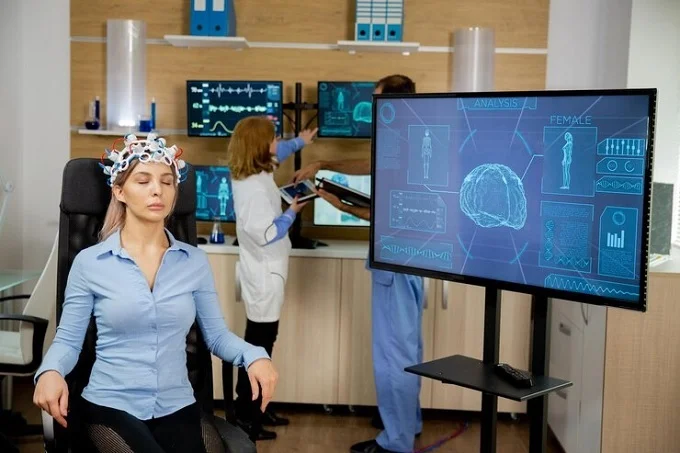Overview
Neuralink, founded by Elon Musk in 2016, is a neurotechnology company with the ambitious goal of developing brain-computer interfaces to connect humans and computers. Their technology aims to implant incredibly small electrodes into the brain that can receive and transmit signals, allowing for the possibility of enhancing human cognitive capabilities. While Neuralink’s technology is still in early development, it has generated significant interest and debate regarding the potential impact on society. In this post, we will explore Neuralink’s capabilities and consider some of the key implications of this emerging field.
Understanding Neuralink
- Overview of Neuralink: Neuralink was founded by Elon Musk and eight others in 2016 as a medical research company focused on developing implantable brain-computer interfaces (BCIs). The company’s mission is to develop the technology to “merge” humans with artificial intelligence through neural implants. Neuralink has raised over $150 million in funding and currently employs around 100 people.
- Technology Behind Neuralink: Neuralink is developing tiny, flexible “threads” that contain electrodes and can be implanted directly into the brain using robotic surgery. This could enable a high bandwidth connection for recording and stimulating brain activity. The threads are 4 to 6 μm in width, thinner than a human hair, and contain up to 3,072 electrodes per thread. The implantable device would connect wirelessly to an external processing unit behind the ear that transmits data to a computer.
Potential Applications
- Medical Advancements: Neuralink aims to first apply their technology to help patients with neurological conditions like paralysis, epilepsy, Parkinson’s disease, and more. The technology could allow patients to control prosthetic limbs or computer cursors just by thinking. It also has potential to treat memory loss, depression, blindness, and other conditions.
- Enhancement of Human Capabilities: Looking further ahead, Neuralink’s brain implants could be used to enhance human abilities. For example, they might improve memory, cognitive skills, reaction time, and more. This raises ethical concerns about the implications of such enhancement technologies.
Ethical and Societal Implications
- Privacy and Security Concerns: Implanting computer chips in brains raises worrying privacy and security issues. Neural data could be transmitted from inside a person’s head, posing a risk of hacking, surveillance, and thought privacy violations. Strict security measures would need to be developed.
- Equality and Accessibility: As an emerging technology only available to a wealthy few, Neuralink implants could exacerbate social inequalities. There are concerns that cognitive enhancements could become limited to those who can pay for them Public discussion is needed to ensure fair access.
Current Challenges and Future Prospects
- Technical Hurdles: Significant technical challenges remain in developing safe, effective neural implants that can be widely adopted. Current prototypes are still large and unwieldy, surgical implantation carries risks and long-term biocompatibility must be ensured. Sure, I’d be happy to add more information to our discussion about Neuralink. Let’s explore some additional aspects of this fascinating technology.
How Neuralink Works
To understand Neuralink better, let’s break down how it actually works:
- The Implant: Neuralink’s main device is a small chip about the size of a coin. This chip is designed to be placed directly on the surface of the brain.
- Tiny Wires: Connected to this chip are many super thin wires. These wires are so small that they’re thinner than a human hair!
- Reading Brain Signals: These tiny wires can pick up the electrical signals that our brain cells (neurons) use to communicate with each other.
- Sending Information: The chip then takes these signals and sends them wirelessly to a computer or other device.
- Interpreting the Signals: Special software then tries to understand what these brain signals mean and turn them into actions.
The Surgical Process
Getting a Neuralink implant isn’t like getting a regular shot at the doctor’s office. It requires a surgical procedure. Here’s how it might work:
- A small part of the skull is carefully removed.
- The chip is placed on the surface of the brain.
- The tiny wires are carefully inserted into the brain.
- The removed part of the skull is put back in place.
Neuralink is working on making this process as safe and easy as possible. They’ve even developed a special robot to help do the surgery!
Comparing Neuralink to Other Brain-Computer Interfaces
Neuralink isn’t the only company working on brain-computer interfaces. Let’s look at how it compares to some others:
- Synchron: This company has developed a device called the Stentrode. Instead of being placed directly on the brain, it’s inserted into a blood vessel near the brain. This means it doesn’t require open brain surgery.
- Blackrock Neurotech: They’ve been working on brain-computer interfaces for many years. Their devices have already been used by some people with paralysis to control computer cursors and robotic arms.
- Precision Neuroscience: This company is working on a very thin, flexible electrode array that can be placed on the surface of the brain with minimal invasiveness.
The Role of Artificial Intelligence
Artificial Intelligence (AI) plays a big role in making brain-computer interfaces work. Here’s how:
- Understanding Brain Signals: AI algorithms are used to interpret the complex patterns of brain activity that the Neuralink chip picks up.
- Learning and Adapting: These AI systems can learn over time, getting better at understanding each person’s unique brain signals.
- Translating Thoughts to Actions: AI helps turn the interpreted brain signals into actual commands for devices or movements for prosthetic limbs.
Potential Future Applications
While helping people with medical conditions is a primary goal, there are many other potential uses for this technology in the future:
- Enhanced Learning: Imagine being able to download information directly to your brain, like learning a new language instantly!
- Improved Mental Health: This technology might help treat conditions like depression or anxiety by allowing more precise control of brain activity.
- Virtual and Augmented Reality: Brain-computer interfaces could make virtual experiences feel more real by directly interfacing with our senses.
- Telepathic Communication: In the far future, we might be able to communicate thoughts directly to each other without speaking.
The Importance of Ethical Guidelines
As this technology develops, it’s crucial that we establish strong ethical guidelines. Some important considerations include:
- Consent: Ensuring that people fully understand and agree to the use of this technology.
- Data Protection: Keeping brain data safe from hackers or unauthorized access.
- Equal Access: Making sure this technology doesn’t create unfair advantages for only those who can afford it.
- Maintaining Human Identity: Ensuring that enhancing our brains doesn’t change who we are as individuals or as a species.
Conclusion
Neuralink and brain-computer interfaces represent an exciting frontier in technology and neuroscience. While there are still many challenges to overcome, the potential benefits are enormous. From helping people with severe disabilities to potentially enhancing human cognition, this technology could change our world in profound ways.
As we move forward, it’s important that we approach this technology with both excitement and caution. We need to carefully consider the ethical implications and ensure that as we develop these powerful tools, we use them in ways that benefit all of humanity.
The future of brain-computer interfaces is just beginning to unfold. It’s an exciting journey, and we’re all part of it. Who knows what amazing discoveries and capabilities lie ahead? The only thing we can be sure of is that the way we interact with technology – and perhaps even with each other – is likely to change in ways we can hardly imagine. Stay curious, stay informed, and get ready for a future where the line between mind and machine may become increasingly blurred!
- Future Possibilities: If technical challenges are overcome, Neuralink’s technology could enable a seamless interface between minds and machines. Beyond medical applications, this could transform human experiences in virtual reality, transportation, education, communication, and more [[17]]. Further public discussion on appropriate and ethical applications is critical.



